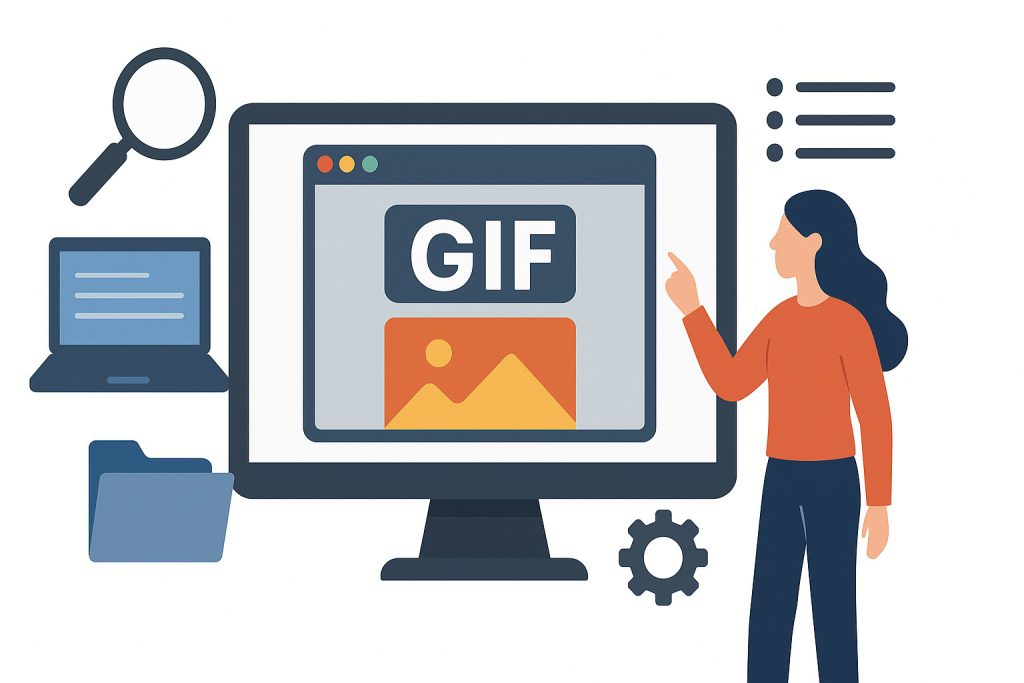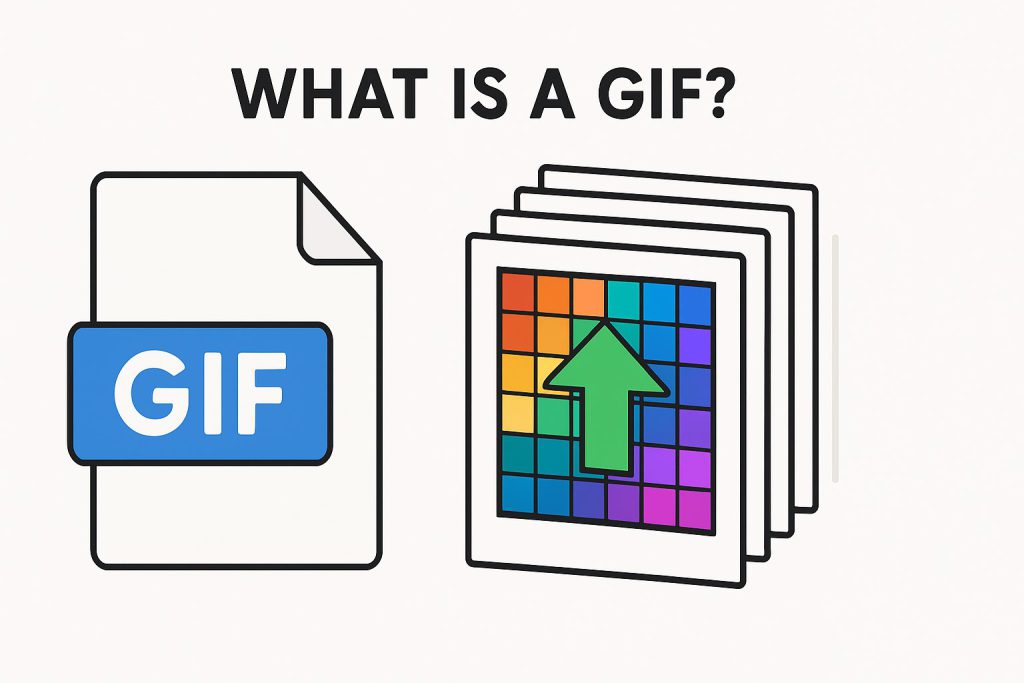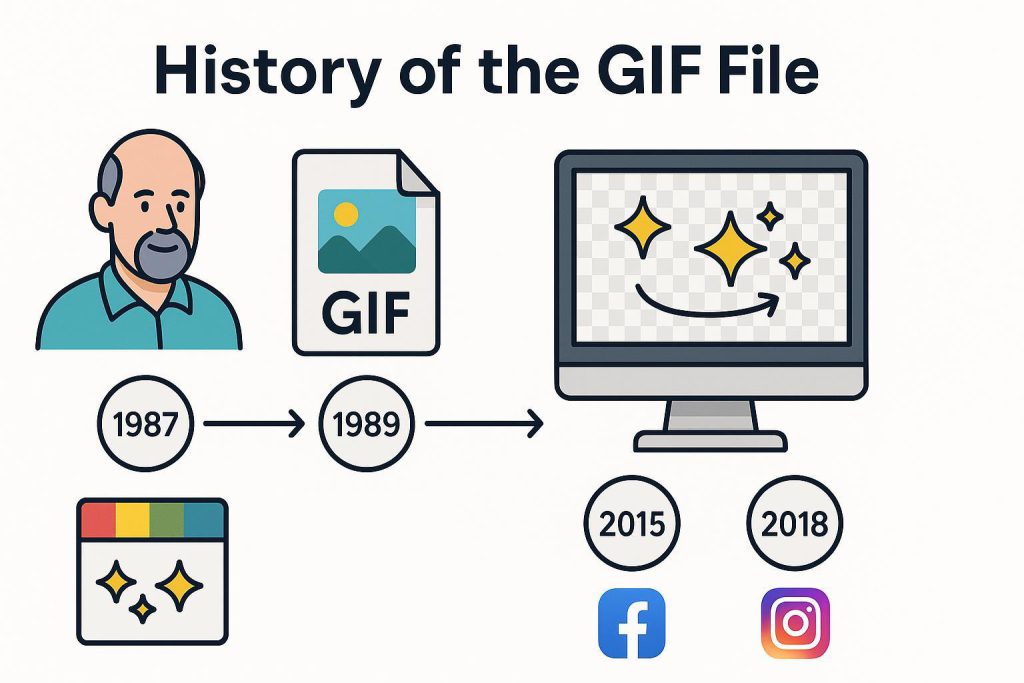
GIF files represent one of the internet’s most recognizable and versatile image formats, combining the magic of moving images with practical digital communication. The Graphics Interchange Format transforms static content into engaging animated GIF files that capture attention across social media platforms. These GIF images have evolved from simple file compression tools to essential elements of social media marketing and web communication. Modern brands leverage GIF file formats to showcase personality, boost engagement through eye-catching animated content, and create easily shareable GIF files that resonate across multiple platforms.
Key takeaways
- GIF stands for Graphics Interchange Format – a bitmap image format supporting up to 256 colors.
- Developed in 1987 by Steve Wilhite and his team at CompuServe for efficient image compression.
- Animation capabilities combine multiple frames to create short, looping video-like sequences.
- Lossless compression maintains image quality while keeping file sizes relatively small.
- Universal compatibility works across all major web browsers and social media platforms.
- Pronunciation debate continues between soft G (like “jif”) and hard G (like “gift”) pronunciations.
- Limited color palette makes GIFs suitable for simple graphics but less ideal for photographs.
What is a GIF?

The Graphics Interchange Format (GIF) is a bitmap image format developed by American computer scientist Steve Wilhite and his team at CompuServe in 1987. The GIF file format can contain up to 8 bits per pixel, allowing a single image to reference its own palette of up to 256 indexed colors chosen from the 24-bit RGB color space. Gif files serve as raster file containers supporting both static images and animations through multiple frames displaying in sequence.
The GIF format utilizes lossless compression technology to maintain image quality while reducing file sizes for faster loading across web browsers and mobile devices. Animated GIFs automatically play in continuous loops without requiring user interaction, making them perfect for creating engaging visual content.
How do you pronounce GIF?
The pronunciation debate continues between soft G (like “giant”) and hard G (like “gift”). Creator Steve Wilhite intended the soft G pronunciation to echo the peanut butter brand Jif. Despite the creator’s preference, many users pronounce GIF with a hard G pronunciation. The Oxford English Dictionary accepts both pronunciations as correct.
History of the GIF File
Steve Wilhite introduced the GIF format on June 15, 1987 while working at CompuServe, the first major online service provider. The initial version, known as GIF87a, replaced CompuServe’s black-and-white image format with a color solution supporting up to 8 bits per pixel. In 1989, CompuServe released the enhanced GIF89a version, adding transparency support and better animation capabilities.
In September 1995, Netscape Navigator 2.0 added the ability for animated GIFs to loop animations automatically. This development marked the beginning of GIF files’ transformation from simple image storage into dynamic animation tools. The GIF file format gained widespread adoption on social media platforms, with Facebook introducing GIF support in 2015 and Instagram following in 2018, cementing animated GIFs’ role in modern digital communication.

What’s the difference between memes and GIFs?
Memes and GIF files represent distinct types of digital media with different purposes. Memes typically consist of text-based content designed primarily for expressing humor or sharing cultural references across social media platforms. Gif images, however, are always image-based animated files that serve multiple communication and marketing purposes beyond humor.
While memes focus on conveying jokes through words and static images, GIF files use moving images to express emotions, demonstrate products, or enhance visual communication. Memes spread rapidly through social sharing, whereas animated GIFs are more commonly embedded in websites and messaging apps.
Why are GIFs popular?
Gif files are gaining popularity because they’re useful for communicating emotions and ideas effectively. The GIF file format’s popularity stems from several key factors that make animated GIFs particularly effective for modern digital communication. Their small file sizes enable quick loading across mobile devices and web browsers, while their automatic looping creates engaging visual experiences.
Gif images excel at conveying complex emotions and messages in formats that text alone cannot achieve. Their typical 2-5 second length perfectly matches modern attention spans, making animated GIFs ideal for social media platforms where users scroll rapidly through content. The GIF format’s versatility allows use cases ranging from entertainment to professional marketing.
Expression
Gif files create a flipbook effect by containing multiple images, giving the impression of a video without sound. Animated GIFs enhance text-based communication by clarifying mood and tone that might otherwise be lost in digital interactions. They effectively convey emotions like frustration, sarcasm, and excitement through easily interpretable moving images.
For brands, GIF images provide opportunities to add humor, establish distinctive voice, and build stronger audience relationships through more expressive communication than static images allow.
Shareability
Gif files provide a simple, lightweight mechanism for promoting products and services. Gif images and animations can be used to share brand images, create banner ads, and show quick animated previews of how products work. Visual content receives significantly higher engagement rates than text-only posts, with animated GIF files particularly effective due to their small file size enabling quick loading.
Social media users are more likely to share posts containing GIF images, helping brands reach wider audiences and boost engagement rates compared to static content.
Cultural commentary
Gif files function as entry points to internet culture, similar to animated memes featuring clips from popular movies, TV shows, and viral videos. Sharing culturally relevant GIF images can spark recognition among social media users, helping them feel connected to content through shared cultural understanding.
This cultural aspect makes animated GIFs powerful tools for brands seeking to demonstrate cultural awareness and connect with audiences through familiar references.
Accessibility
You can create GIFs using tools like Adobe Photoshop or Adobe Premiere for advanced editing. For casual users, online tools and app-based platforms allow anyone to generate GIFs from video clips or still images. Creating GIF files doesn’t require specialized video teams or expensive equipment, making them accessible to content creators of all skill levels.
Numerous free online tools enable users to create GIFs without editing or coding skills, democratizing animated content creation.
What are GIFs used for?
The GIF file format is designed to display simple graphics and animations effectively. Gif files serve multiple purposes in digital communication and marketing, from basic web graphics to complex animated content that enhances user engagement across various platforms.
Web graphics and logos
Gif files are well suited for sharp-edged line art with relatively few colors, such as logos. This takes advantage of the GIF format’s lossless compression, which favors flat areas of uniform color with well-defined edges. The image file format excels with simple graphics featuring sharp lines rather than high-quality photographs due to the 256-color limitation.
Gif images work particularly well for basic web graphics and brand assets where defined edges create clean, professional appearances.
Memes and online animations
You’ll encounter endless animated GIFs on websites and social media platforms. Gif files create moving images by containing multiple frames, giving the impression of video content without sound. Animated GIFs have become central to meme culture and online messaging, providing quick ways to express emotions and share cultural references.
Their low resolution and lack of sound contribute to their charm and shareability, creating recognizable animated content that works universally across platforms.
Who is using GIFs on social media?
Gif usage has evolved dramatically from niche platforms to mainstream social media integration. Early adoption occurred on sites like Tumblr, BuzzFeed, and Reddit, where social media users embraced animated GIF files for creative expression. Most web browsers now support GIF files natively, making them accessible across all platforms.
The GIF file format gained mainstream acceptance when major platforms integrated GIF search functionality. Facebook introduced a GIF search engine to Messenger in July 2015, while Twitter implemented similar features in February 2016. This integration transformed GIF files from novelty content into standard communication tools.
Remote work has further normalized GIF usage in professional settings, particularly in messaging apps like Slack. Teams use animated GIFs to compensate for reduced face-to-face interaction, better conveying tone and personality in digital workplace communications.
Converting GIF to other formats
Converting GIF files to other image formats becomes necessary when integrating with different systems or meeting specific technical requirements. Various conversion methods exist for transforming animated GIFs into static images or alternative formats depending on intended use cases.
Professional conversion tools offer batch processing capabilities for handling large numbers of GIF files efficiently while preserving image quality. These tools provide options for managing attachments and addressing encoding issues during format transitions.
Essential conversion options include:
- GIF to JPG – Creates static images suitable for photography.
- GIF to BMP – Generates uncompressed bitmap files for maximum quality.
- GIF to TIFF – Produces high-quality images suitable for professional printing.
- GIF to PNG – Maintains transparency while supporting broader color ranges.
- GIF to PDF – Creates document-friendly formats for presentations.
Pros and cons of GIF files
Understanding both advantages and disadvantages of the GIF file format helps determine when this popular file format suits specific communication needs versus other image formats.
Advantages of GIF files
What GIF animations lack in sophistication they make up for with speed and impact. They’re quick to create GIFs, don’t require technical know-how, and can spread across social media platforms like wildfire as memes. Key benefits include their viral potential as shareable content and relatively small file sizes that enable faster web page loading.
The GIF file format boasts lossless compression technology. This means image quality doesn’t decline when data gets compressed. This compression maintains visual integrity while reducing file sizes, making GIF files efficient for quick-impact visual communication.
Disadvantages of GIF files
The GIF file format only supports a palette of 256 colors, meaning GIF images may have low resolution or appear blurry. Several significant limitations affect GIF effectiveness in certain applications. The restricted color palette can result in poor image quality for detailed photographs requiring color gradients.
Because they use multiple images, animated GIF files can be tricky to edit after creation. Additional drawbacks include editing difficulties, potential loading issues on slow connections, risk of content becoming outdated, and diminishing returns from overuse. Website performance can suffer from excessive GIF usage, potentially affecting SEO rankings. Accessibility concerns arise as screen readers struggle with GIF interpretation.
How to open a GIF file
Opening GIF files requires straightforward processes across different operating systems. Simply search for the GIF file name and double-click when it appears. Most major image editing programs including Adobe Photoshop support the GIF file format natively, making it easy to open GIF files for viewing or editing.
Web browsers provide another reliable method for viewing GIF files. Most web browsers including Chrome, Firefox, and Internet Explorer handle the GIF file format effectively, allowing users to view animated GIFs directly in browser windows.
Tools for making GIFs
You can create GIFs using tools like Adobe Photoshop or Adobe Premiere for advanced editing. For casual users, online tools such as GIPHY’s GIF Creator or app-based platforms allow anyone to generate GIFs from video clips. Professional software offers advanced capabilities, but you don’t need image editing skills due to numerous simpler alternatives.
The basic process involves selecting source material in various file formats including MOV, JPG, MPG, WebM, and PNG. User-friendly online tools have democratized GIF creation, enabling content creators to create GIFs without technical expertise.
How to create and edit a GIF file
Creating animated GIFs using Adobe Photoshop involves systematic steps for optimal results. The process begins with uploading source material through File > Scripts > Load Files into Stack, followed by creating frame animations in the Timeline panel. Configure frames from layers, set repeat options to loop forever, preview the animation, and export through File > Export > Save for Web.
Essential tips for creating GIFs include using high-quality source material, keeping GIF files concise for maximum impact, maintaining consistent frame rates, and adding text or captions for context. Experiment with filters and effects to make your own GIFs unique and eye-catching.
GIFs and Cybersecurity: Understanding the Risks
The trusted nature of GIF files can be exploited by cybercriminals seeking to deliver malicious content through seemingly innocent animated GIFs. Gif images use lossless compression to reduce file size without degrading visual quality, but malicious actors can use steganography techniques to conceal harmful content within multiple frames.
Infected GIF files can deploy various types of malware including spyware and ransomware when executed, creating gateways for intrusive attacks while appearing normal to users. This makes animated GIFs particularly dangerous vectors for security breaches that can evade traditional detection methods.
Organizations should implement robust antivirus protection and intrusion detection systems to identify potentially compromised GIF files before they cause damage.
FAQs
What is GIF short for?
GIF stands for Graphics Interchange Format, a bitmap image file format developed by Steve Wilhite and his team at CompuServe in 1987 for compressing and sharing color images efficiently.
What is a GIF on my phone?
A GIF on your phone is an animated image file that plays short, looping sequences without sound. Mobile messaging apps typically include built-in GIF libraries for quick sharing and communication.
What does GIF mean in texting?
In texting, GIF files function as animated visual responses that convey emotions, reactions, or humor more effectively than words alone, enhancing digital communication through moving images and cultural references.
Why would someone use a GIF?
People use GIF files to express emotions quickly, add visual interest to communications, create engaging social media content, demonstrate products or processes, and participate in internet culture through shared references.